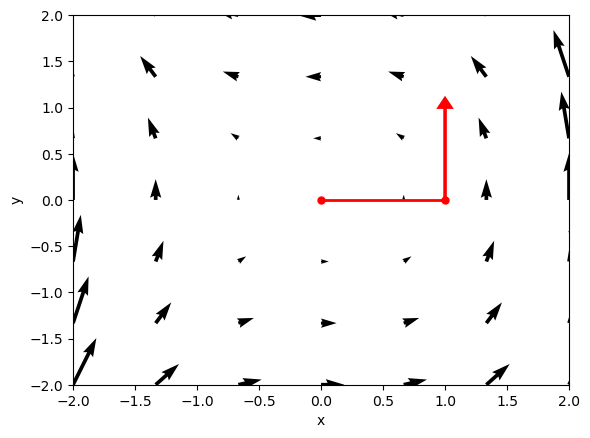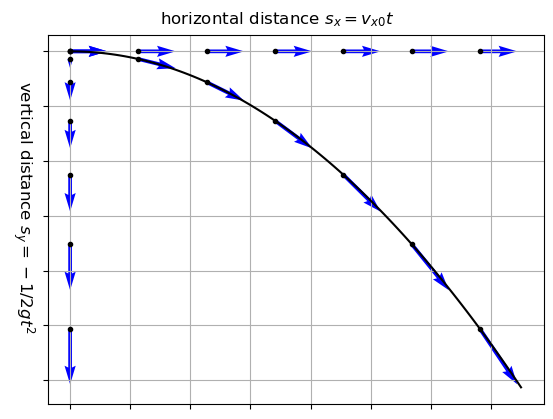#test widget
import numpy as np
import matplotlib.pyplot as plt
from ipywidgets import interact
import ipywidgets as widgets
mass_sun = 1.989e30 # kg
mass_halley = 2.2e14 # kg
G = 6.67430e-11 # m^3 kg^-1 s^-2
# perihelion halley
AU = 149e9 #m
v_halley = 54.68e3 # m/s
r_halley = 0.586 * AU # m
# settings
dt = 24 * 3600 # seconds
t = 75 * 365 * 24 * 3600 # seconds
N = int(t / dt)
# Ic.
v_h = np.zeros((N,2))
v_h[0,:] = [0,v_halley]
r_h = np.zeros((N,2))
r_h[0,:] = [r_halley,0]
t_arr = np.linspace(0,t+dt,N)
# RK4 method
def acceleration(r):
r_norm = np.linalg.norm(r)
return -G * mass_sun * r / r_norm**3
for i in range(1, N):
# r and v at time t
r0 = r_h[i-1, :]
v0 = v_h[i-1, :]
# k1
k1_v = acceleration(r0) * dt
k1_r = v0 * dt
# k2
k2_v = acceleration(r0 + 0.5 * k1_r) * dt
k2_r = (v0 + 0.5 * k1_v) * dt
# k3
k3_v = acceleration(r0 + 0.5 * k2_r) * dt
k3_r = (v0 + 0.5 * k2_v) * dt
# k4
k4_v = acceleration(r0 + k3_r) * dt
k4_r = (v0 + k3_v) * dt
# update velocity and position
v_h[i, :] = v0 + (k1_v + 2 * k2_v + 2 * k3_v + k4_v) / 6
r_h[i, :] = r0 + (k1_r + 2 * k2_r + 2 * k3_r + k4_r) / 6
# Plotting the trajectory
def sim_kep(t_sim):
plt.figure(figsize=(10, 6))
plt.xlabel('X Position (m)')
plt.ylabel('Y Position (m)')
plt.plot(r_h[:, 0], r_h[:, 1], label='Halley\'s Trajectory', color='lightgray')
# plt.plot(r_h[N, 0], r_h[N, 1], 'r.')
plt.scatter(0, 0, color='yellow', s=100, label='Sun') # Sun at origin
plt.gca().set_aspect('equal')
# plt.title('Earth Trajectory Around the Sun')
plt.title('Halley\'s Trajectory Around the Sun')
for i in range(1,t_sim,int(N/15)):
plt.plot(r_h[:i, 0], r_h[:i, 1], label='Earth Trajectory', color='black')
plt.plot(r_h[i, 0], r_h[i, 1], 'r.')
plt.arrow(0,0,r_h[i, 0], r_h[i, 1], color='darkgreen')
plt.text(0,5e11, str(int(t_sim/(365)))+'years')
plt.grid()
#plt.legend()
plt.show()
interact(sim_kep, t_sim=widgets.IntSlider(min=0, max=N-1, step=int(N/15), value=1))Source
import numpy as np
import matplotlib.pyplot as plt
from matplotlib.animation import FuncAnimation
# Simulation settings
V = 50
x1, y1 = 220, 320
x2, y2 = 720, 320
t_stop = 5
dt = 0.025 # 25 ms
yBounce = 430
tstar = (yBounce - y1) / V
fps = int(1 / dt)
# Time values
t_values = np.arange(0, t_stop, dt)
# Position logic
def ball1_y(t):
if t < tstar:
return y1 + V * t
else:
return yBounce - V * (t - tstar)
def ball2_y(t):
if t < tstar:
return y2
else:
return y2 - 2 * V * (t - tstar)
# Setup figure
fig, ax = plt.subplots(figsize=(10, 5))
ax.set_xlim(0, 1000)
ax.set_ylim(0, 500)
ax.set_title("Bouncing Ball")
ball1, = ax.plot([], [], 'ro', markersize=10)
ball2, = ax.plot([], [], 'bo', markersize=10)
wall1 = plt.Rectangle((160, yBounce+10), 120, 10, color='black')
wall2 = plt.Rectangle((660, yBounce+10), 120, 10, color='black')
ax.add_patch(wall1)
ax.add_patch(wall2)
def init():
ball1.set_data([], [])
ball2.set_data([], [])
return ball1, ball2, wall1, wall2
def update(frame):
t = t_values[frame]
y1_now = ball1_y(t)
y2_now = ball2_y(t)
ball1.set_data(x1, y1_now)
ball2.set_data(x2, y2_now)
wall2.set_xy((660, yBounce + 10 - V * t if t < tstar else yBounce + 10 - V * t))
return ball1, ball2, wall1, wall2
anim = FuncAnimation(fig, update, frames=len(t_values), init_func=init, interval=dt*1000, blit=True)
plt.close() # Avoid double display in notebooks
from IPython.display import HTML
HTML(anim.to_jshtml())
Source
import numpy as np
import matplotlib.pyplot as plt
from matplotlib.animation import FuncAnimation
# Parameters
v = 1.0 # snelheid in x-richting
t_max = 10 # totale simulatie tijd
dt = 0.05 # tijdstap in seconden
y = 0.5 # constante y-positie
# Tijdwaarden
t_values = np.arange(0, t_max, dt)
# Setup plot
fig, ax = plt.subplots(figsize=(8, 4))
ax.set_xlim(0, v * t_max + 1)
ax.set_ylim(0, 1)
ax.set_xlabel("x")
ax.set_ylabel("y")
ax.set_title("Deeltje met constante snelheid")
# Plot-elementen
particle, = ax.plot([], [], 'ro', markersize=10)
time_text = ax.text(0.98, 0.95, '', transform=ax.transAxes,
ha='right', va='top', fontsize=12)
# Initialisatie
def init():
particle.set_data([], [])
time_text.set_text('')
return particle, time_text
# Update-functie
def update(frame):
t = t_values[frame]
x = v * t
particle.set_data(x, y)
time_text.set_text(f"t = {t:.2f} s")
return particle, time_text
# Animatie aanmaken
ani = FuncAnimation(fig, update, frames=len(t_values),
init_func=init, interval=dt*1000, blit=True)
# In notebook tonen
from IPython.display import HTML
plt.close() # voorkom dubbele weergave
HTML(ani.to_jshtml())
Output
Solution to Exercise 1
Two are easy: constant motion () and constant acceleration , with .
Consider the third being a harmonic oscillating force field: Then the equation of motion becomes:
Assuming
And,
Assuming
Hence:
Now, finding traveling the same distance in the same time AND the harmonic oscillation is complete (hence, ):
Source
# Animatie van een deeltje met constante snelheid en een deeltje met constante versnelling
import numpy as np
import matplotlib.pyplot as plt
from matplotlib.animation import FuncAnimation
from IPython.display import HTML
# Parameters
v = 1.0 # snelheid in x-richting
dt = 0.05 # tijdstap in seconden
t_max = 10 + dt # totale simulatie tijd
y = 0.5 # constante y-positie
a = 2*v**2/(v*(t_max-dt)) # versnelling in x-richting
m = 1.0 # massa van het deeltje
A = - v*2*np.pi / (t_max-dt) # amplitude van de sinusgolf
f = 1 / (t_max-dt) # frequentie van de sinusgolf
# Vooraf posities berekenen
t_values = np.arange(0, t_max, dt)
x_values = v * t_values
x_values_2 = 1/2 * a * t_values**2 # voor een andere beweging
x_values_3 = A / (m * (2 * np.pi * f)**2) * np.sin(2 * np.pi * f * t_values) - A / (m * 2 * np.pi * f) * t_values
y_values = np.full_like(x_values, y) # constante y
# Setup plot
fig, ax = plt.subplots(figsize=(8, 4))
ax.set_xlim(0, x_values[-1] + 1)
ax.set_ylim(0, 2)
ax.set_xlabel("x")
ax.set_ylabel("y")
particle, = ax.plot([], [], 'ro', markersize=10, label='Deeltje met constante snelheid')
particle_2, = ax.plot([], [], 'bo', markersize=10, label='Deeltje met constante versnelling')
particle_3, = ax.plot([], [], 'go', markersize=10, label='Deeltje in oscillerend krachtveld')
ax.legend(loc='upper left')
time_text = ax.text(0.98, 0.95, '', transform=ax.transAxes,
ha='right', va='top', fontsize=12)
# Initialisatie
def init():
particle.set_data([], [])
particle_2.set_data([], [])
particle_3.set_data([], [])
time_text.set_text('')
return particle, time_text
# Update per frame
def update(frame):
x = x_values[frame]
x_2 = x_values_2[frame]
x_3 = x_values_3[frame]
y = y_values[frame]
t = t_values[frame]
particle.set_data([x], [y])
particle_2.set_data([x_2], [2*y])
particle_3.set_data([x_3], [.5*y])
time_text.set_text(f"t = {t:.2f} s")
return particle, time_text
# Animatie
ani = FuncAnimation(fig, update, frames=len(t_values),
init_func=init, interval=dt*1000, blit=True)
plt.close()
HTML(ani.to_jshtml())
import numpy as np
import matplotlib.pyplot as plt
from matplotlib.animation import FuncAnimation
from IPython.display import HTML
# Simulatieparameters
dt = 0.05
t_max = 10
t_values = np.arange(0, t_max, dt)
# Fysische parameters
vx = 1.0
Fy = 1.0
m = 1.0
ay = Fy / m
# Posities berekenen
x = vx * t_values
y = np.zeros_like(t_values)
x_burn_start = 2.0
x_burn_end = 4.0
i_start = np.argmax(x >= x_burn_start)
i_end = np.argmax(x >= x_burn_end)
for i in range(i_start, i_end+1):
t_burn = t_values[i] - t_values[i_start]
y[i] = 0.5 * ay * t_burn**2
vy_final = ay * (t_values[i_end] - t_values[i_start])
y0 = y[i_end]
t0 = t_values[i_end]
for i in range(i_end, len(t_values)):
y[i] = y0 + vy_final * (t_values[i] - t0)
# Plot
fig, ax = plt.subplots(figsize=(8, 4))
ax.set_xlim(0, np.max(x)+1)
ax.set_ylim(0, np.max(y)+1)
ax.set_xlabel("x")
ax.set_ylabel("y")
ax.set_title("🚀 Raket met stuwfase tussen x=2 en x=4")
# Raket (emoji als tekst)
rocket = ax.text(0, 0, '🚀', fontsize=14)
# Trail
trail, = ax.plot([], [], 'r-', lw=1)
# Tijd
time_text = ax.text(0.98, 0.95, '', transform=ax.transAxes,
ha='right', va='top', fontsize=12)
# Init
def init():
rocket.set_position((0, 0))
trail.set_data([], [])
time_text.set_text('')
return rocket, trail, time_text
# Update
def update(frame):
rocket.set_position((x[frame], y[frame]))
trail.set_data(x[:frame+1], y[:frame+1])
time_text.set_text(f"t = {t_values[frame]:.2f} s")
return rocket, trail, time_text
# Animatie
ani = FuncAnimation(fig, update, frames=len(t_values),
init_func=init, interval=dt*1000, blit=True)
plt.close()
HTML(ani.to_jshtml())
import numpy as np
import matplotlib.pyplot as plt
x = np.linspace(-2, 2, 7)
y = np.linspace(-2, 2, 7)
X, Y = np.meshgrid(x, y)
U = - Y
V = X**2
path_x = [0, 1]
path_y = [0, 0]
plt.figure()
plt.arrow(1, 0, 0, 1, head_width=0.1, head_length=0.1, fc='red', ec='red', linewidth=2)
plt.plot(path_x, path_y, color='red', linewidth=2, marker='o', markersize=5)
plt.quiver(X, Y, U, V, color='k')
plt.xlim(-2, 2)
plt.ylim(-2, 2)
plt.xlabel('x')
plt.ylabel('y')
plt.savefig('images/force_field.png', dpi=300)
plt.show()

import numpy as np
import matplotlib.pyplot as plt
t = np.linspace(0, 5, 100)
v_x = 30
a = 9.81
s_x = v_x * t
s_y = -0.5 * a * t**2
N = 15
plt.figure()
plt.plot(s_x, s_y, 'k-' )
plt.plot(s_x[::N], s_y[::N], 'k.' )
plt.plot(s_x[::N], s_y[::N]*0, 'k.' )
plt.plot(s_x[::N]*0, s_y[::N], 'k.' )
plt.quiver(s_x[::N], s_y[::N]*0, v_x, 0, color='blue', scale=400)
plt.quiver(s_x[::N]*0, s_y[::N], 0, -a*t[::N], color='blue', scale=400)
plt.quiver(s_x[::N], s_y[::N], v_x, -a*t[::N], color='blue', scale=400)
plt.gca().set_xticklabels([])
plt.gca().set_yticklabels([])
plt.grid(visible=True)
plt.text(30, 10, 'horizontal distance $s_x=v_{x0}t$', fontsize=12, color='black')
plt.text(-20, -100, 'vertical distance $s_y=-1/2gt^2$', fontsize=12, color='black',rotation=-90)
plt.savefig('../images/parmotionv.png', dpi=300)
plt.show()

import numpy as np
import matplotlib.pyplot as plt
N = 1.5
x = np.linspace(-N, N, 15)
y = np.linspace(-N, N, 15)
X, Y = np.meshgrid(x, y)
U = Y
V = -X
plt.figure(figsize=(4, 4))
plt.plot([0,1], [0,0], color='red', linewidth=2, marker='o', markersize=5)
plt.plot([1,1], [0,1], color='red', linewidth=2, marker='o', markersize=5)
plt.plot([1,0], [1,1], color='red', linewidth=2, marker='o', markersize=5)
plt.plot([0,0], [1,0], color='red', linewidth=2, marker='o', markersize=5)
plt.arrow(1, 0, 0, .5, head_width=0.1, head_length=0.1, fc='red', ec='red', linewidth=2)
plt.arrow(0, 1, 0, -.5, head_width=0.1, head_length=0.1, fc='red', ec='red', linewidth=2)
plt.arrow(0, 0, 0.5, 0, head_width=0.1, head_length=0.1, fc='red', ec='red', linewidth=2)
plt.arrow(1, 1, -0.5, 0, head_width=0.1, head_length=0.1, fc='red', ec='red', linewidth=2)
#plt.plot(path_y, path_z, color='red', linewidth=2, marker='o', markersize=5)
plt.quiver(X, Y, U, V, color='k')
plt.xlim(-.5*N, N)
plt.ylim(-.5*N, N)
plt.xlabel('x')
plt.ylabel('y')
plt.savefig('../images/StokesTheoremExample.png', dpi=300)
plt.show()

import numpy as np
import matplotlib.pyplot as plt
c = 299792458 # speed of light in m/s
x = np.linspace(0, c, 1000)
y = 1 / np.sqrt(1 - (x / c)**2)
plt.figure(figsize=(8, 6))
plt.plot(x/c, y, 'k.')
plt.show()
C:\Users\fpols\AppData\Local\Temp\ipykernel_20688\3696628937.py:6: RuntimeWarning: divide by zero encountered in divide
y = 1 / np.sqrt(1 - (x / c)**2)
